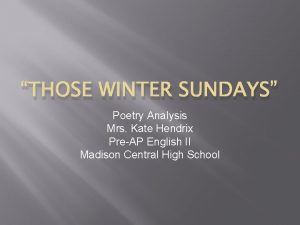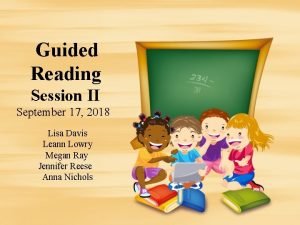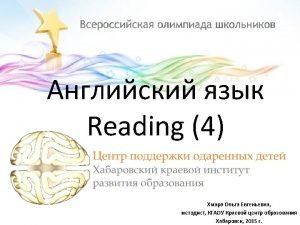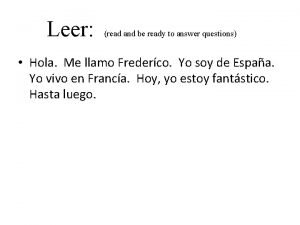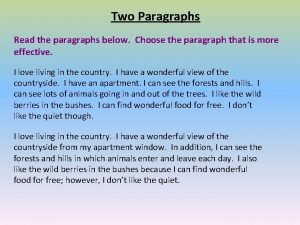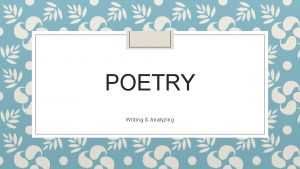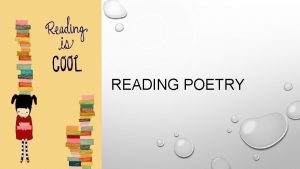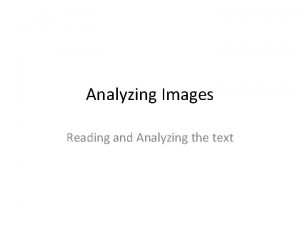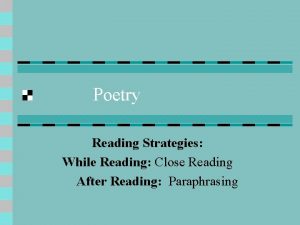Reading and Analyzing Poetry How to read poetry











- Slides: 11

Reading and Analyzing Poetry

How to read poetry End-stopped line: A line of poetry that has some form of punctuation at the end. As a reader, you need to pause—take a breath! Enjambed line: A line of poetry that keeps going —there is no punctuation at the end. Do not stop reading – keep going on to the next line!

Speaker Vs. Poet Speaker: This is the imagined narrator of the poem. Speaker and poet should be separated. Think about an imagined character or persona you can create for the speaker: Who is he/she? Think about age, gender, beliefs, upbringing, etc. In many cases, the speaker is the same gender as the poet! Poet: The author of the poem.

Analyzing Poetry – The Steps When we read analyze a poem – there are 7 steps to complete in order to obtain a full analysis. Here they are: 1. ) Title 2. ) Paraphrase 3. ) Connotation/Literary Devices 4. ) Attitude 5. ) Shift 6. ) Title again 7. ) Theme

Step 1: Title Make predictions about the poem’s content based on the title. Does the title have a literal meaning (denotative meaning)? Does the title have a figurative meaning (connotative meaning)? Examples: Cool Dog

Step 2: Paraphrase Break the poem down line by line or stanza by stanza. Summarize the poem in your own words.

Step 3: Connotation/Literary Devices Break down the words! Look at: • Denotations: Dictionary/literal definitions of words • Connotations: Figurative meaning of words— what other meanings do the words have? • Literary Devices: Think about their meaning and the poet’s purpose

Step 4: Attitude Determine the poet’s feelings or attitude towards a subject in the poem. This is also called tone. Example: What is the poet’s attitude toward love, music, and chocolate ice cream?

Step 5: Shift These are major changes in a poem. Look for changes in content, attitude, time and place, punctuation, line divisions, and structure. Shifts are done on purpose. Think about the poet’s reasons for the shifts.

Step 6: Title Again Re-read the poem’s title. Connect the title to the analysis of your poem. Think about the title’s purpose.

Step 7: Theme Look for patterns in the poem. Consider repeated images, words, phrases, etc. Determine how these patterns create a theme. Think about the moral or lesson. Express themes as a complete sentence.
 Pre reading while reading and post reading activities
Pre reading while reading and post reading activities Those winter sundays meaning
Those winter sundays meaning Shared reading vs read aloud
Shared reading vs read aloud Read the text and answer the questions that follow
Read the text and answer the questions that follow Reading read and answer the questions en español
Reading read and answer the questions en español Aims and objectives of reading
Aims and objectives of reading Stages of reading skills
Stages of reading skills Intensive reading and extensive reading
Intensive reading and extensive reading For adult
For adult Types of reading skill
Types of reading skill Shared reading vs read aloud
Shared reading vs read aloud Read the paragraph below and
Read the paragraph below and

